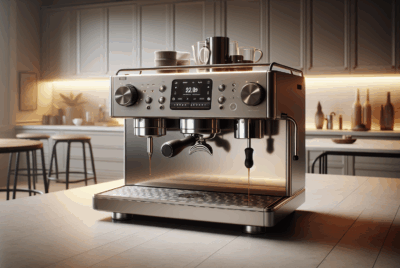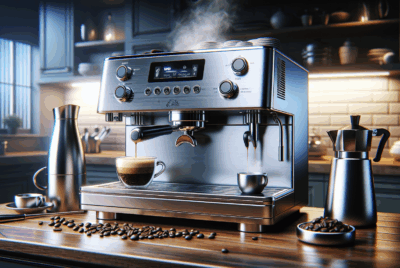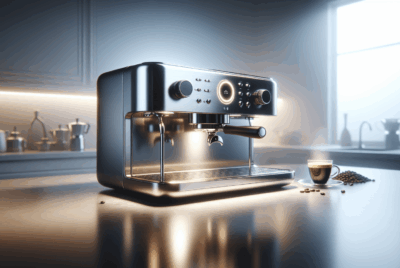Espresso Machine Service: Ensuring Optimal Performance
As an Amazon Associate, I earn from qualifying purchases, at no additional cost to you. Disclaimer
Owning an espresso machine means enjoying delicious coffee at home, but it also requires some care to keep it running well.
Regular service of your espresso machine helps maintain its performance and extends its lifespan. If machines aren’t serviced properly, they might not heat water correctly or could even break down.

I always check for signs that my machine might need servicing. These signs include slower brew times or strange noises.
Pay attention to the way your espresso tastes. Odd flavors can mean it’s time for a tune-up.
Caring for your espresso machine improves your coffee experience. Doing so can make sure that each cup you brew is as good as the last. Find out why this attention to maintenance makes such a big difference in the long run.
Understanding Espresso Machines
Espresso machines are intricate devices that brew a rich, concentrated coffee. Understanding the types and components is vital for anyone aiming to get the best out of their machine.
Types of Espresso Machines
Espresso machines come in various types, suited for different needs.
Manual machines, like the La Pavoni, give me total control but require skill. Semi-automatic machines, such as the Rancilio or Breville, let me control the grind and tamp, but automate the press. Fully automatic machines handle most of the process for me, which is ideal for quick brewing.
Home units often brighten my mornings with simple operation and consistent quality. Brands like Gaggia offer reliable models that are easy to use. Commercial options, like those from Rocket, cater to high-volume needs, providing more features to enhance performance.
Key Components and Functions
The heart of any espresso machine includes several vital parts, including the pump, boiler, and grinder.
The pump, usually rotary or vibratory, helps me achieve the right pressure. This is crucial for extracting the best coffee flavor. Boilers heat water to the precise temperature needed for brewing.
Grinders, integral to any quality machine, produce the right coffee particle size. I find conical burr grinders most effective, as they provide even, consistent grounds.
These machines also include portafilters and steam wands. Portafilters hold the ground coffee during brewing. Steam wands help me froth milk, essential for making lattes and cappuccinos. Understanding each part helps me maintain and operate my espresso machine efficiently.
Routine Espresso Machine Care
Taking care of an espresso machine involves more than just occasional wiping. Regular cleaning and decalcification keep it in top shape. Consistent maintenance prevents problems and improves performance.
Regular Cleaning and Maintenance
I make sure to clean the espresso machine every day. This helps prevent buildup and ensures good flavor.
I start by emptying and rinsing the drip tray and water reservoir. I make sure no water is left standing.
I wipe the steam wand after each use. A damp cloth removes milk residue before it dries.
For deep cleaning, I soak removable parts like portafilters and baskets in warm, soapy water weekly.
Regular maintenance also includes checking seals and gaskets for wear. If they look worn or cracked, I replace them. Lubricating moving parts, as recommended by the manufacturer, keeps the machine running smoothly.
Avoiding harsh chemicals is important. They can damage machine parts or affect taste. Only food-safe products should be used, especially on components in contact with coffee or water.
Decalcification Process
Decalcification is necessary to remove limescale buildup. This buildup can affect water flow and heat efficiency.
Frequency depends on local water hardness. I usually run a decalcification cycle every 3 to 6 months.
To start, I use a descaling solution or vinegar mixed with water. I fill the water tank with this mixture.
Next, I run the machine without coffee, allowing the solution to circulate. This helps break down the scale.
Afterward, I rinse thoroughly, running several cycles with fresh water.
I pay attention to the manufacturer’s instructions during decalcification. Some models might have specific procedures. Proper decalcification extends machine lifespan and maintains optimal coffee quality.
Troubleshooting Common Issues

When dealing with espresso machine service, there are a few common issues that may need attention. I focus on identifying these problems and suggest quick fixes for them. This helps reduce downtime and ensures a smooth coffee-making experience.
Identifying Common Problems
Espresso machines can face several typical problems. One frequent issue is inconsistent water temperature. If the water is too hot or too cold, it affects the taste of the espresso.
Another problem can be low pressure, hindering proper extraction.
Blockages are also common. They often happen in the group head or steam wand. Noticing leaks around the machine could signal worn-out seals or gaskets. Grinding irregularities can lead to uneven coffee grounds, affecting flavor.
It’s essential to pay close attention to maintenance and cleaning schedules. Regular servicing prevents these issues from escalating. Recognizing these signs early often allows me to take immediate action, reducing the need for major espresso repair or technical support.
Diagnostics and Quick Fixes
For inconsistent water temperature, I first check the thermostat settings. Adjusting these can usually bring the machine back to the ideal brewing range. If the problem persists, testing or replacing the heating element might be necessary.
Low pressure could stem from a clogged pump or worn-out parts. Cleaning the pump and inspecting the seals can often restore pressure.
For blockages, I use a mix of water and a descaler. This clears out mineral build-ups effectively.
Leaks are often the result of faulty seals. Replacing these parts usually solves the issue quickly. As for grinding irregularities, inspecting the grinder and adjusting its settings can help achieve a consistent grind.
These quick fixes often delay the need for professional espresso machine repair, saving both time and money.
Professional Espresso Machine Service

Professional service for espresso machines ensures they work efficiently and last longer. I need to understand when to seek expert help, how to choose the right service center, and what happens during the service process.
When to Seek Expert Service
I know it’s time to seek expert service when my espresso machine starts showing signs of wear, like leaks, unusual noises, or weak coffee.
Brands like Saeco and DeLonghi might be complicated for home fixes.
Regular maintenance every few months can prevent major breakdowns. In emergencies, especially with high-end machines like La Marzocco, immediate help is crucial.
Expert service is important to handle complex problems and to prevent further issues. They have specialized knowledge about various espresso machine models.
Choosing a Service Center
Choosing the right service center is important. I look for certified centers that specialize in my espresso machine brand.
For example, some centers focus on Saeco or DeLonghi. I check reviews and ask for recommendations.
Stefano’s Espresso Care is one such trusted option. They offer authorized repairs and might issue a repair authorization number for tracking.
Certified centers ensure quality work using genuine parts. Their technicians are trained to deal with intricate issues, giving me peace of mind. I always confirm if they provide emergency repairs for unexpected problems.
The Service Process
When I take my machine in for service, the process usually starts with a thorough inspection. Technicians identify any worn-out parts, such as seals or filters, that need replacement.
La Marzocco machines, for instance, might need more detailed checks.
They clean and descale the machine to ensure proper function. After repairs, they test the machine to make sure it runs perfectly. Any updates or upgrades are also recommended during this process.
I’m often informed about potential issues to keep an eye out for in the future. This helps in planning regular maintenance, extending the machine’s lifespan.
Maintenance of Specific Brands

Different espresso machines require unique care routines. Let me walk you through the essentials for maintaining top brands like Saeco, Jura, and Rancilio. Proper upkeep ensures your machine delivers the best coffee quality and prolongs its life.
Saeco Maintenance Guide
I ensure to clean my Saeco machine every week after heavy use. Regular descaling is crucial, as mineral deposits can affect performance. I use a Saeco descaling solution once a month to prevent this.
I recommend cleaning the brew group weekly. Remove and rinse it in warm water, letting it dry before reinserting it. Lubricate the moving parts with food-grade lubricant to keep it running smoothly.
Daily, I empty and clean the drip tray and coffee grounds container. This practice avoids mold buildup and keeps the machine ready for use.
Maintaining Your Jura
Jura espresso machines are known for their quality. I perform a full clean cycle monthly, which involves a special cleaning tablet. This helps in removing coffee oils that can clog the system.
The machine alerts me when it’s time to descale or clean, making upkeep easier.
Filter changes are necessary, and I replace them according to usage levels. This ensures water is free from contaminants that affect flavor.
Milk frothers require attention, too. After every use, I clean the frothing system with water and milk system cleaner to avoid any blockages.
Caring for Your Rancilio
For Rancilio machines, backflushing is an essential task I perform weekly. I use a backflush detergent to keep the group head free from coffee residues.
Descaling is less frequent due to high-quality build but still important. I follow the manufacturer’s guidelines for descaling solutions and frequency.
Steam wands need immediate attention after use. I wipe them with a wet cloth to prevent milk buildup. Checking and tightening loose screws ensure the machine stays in good shape.
I find that taking these simple steps helps maintain a Rancilio machine efficiently.
Enhancing Espresso Machine Performance
To keep an espresso machine running at its best, I focus on two main areas: extraction quality and component upgrades. Good care can make a huge difference in both taste and lifespan.
Optimizing Extraction Quality
Achieving perfect espresso depends on extraction. I ensure the grind size matches the espresso machine.
Grinders should be regularly adjusted and maintained. For instance, if I notice my coffee tastes sour, I fine the grind. If it’s too bitter, I coarsen it.
Regular cleaning is also crucial. Coffee oils and grounds can build up, altering taste.
I pay attention to the water temperature and flow rate. Pumps need to be checked to ensure they provide steady pressure. Consistency is the key to great espresso.
Upgrading Machine Components
Sometimes, upgrading parts is necessary. I might replace worn-out pumps or get a better grinder.
Brands like Bezzera and Pasquini offer excellent, reliable parts.
I consider adding features like pre-infusion, which wets the coffee before full pressure is applied. This can help improve flavor.
Using high-quality components can improve performance and durability. It ensures each shot is the best it can be.
Warranty and Espresso Machine Services
Choosing an espresso machine is just the beginning. It’s important to understand the warranty and service options available to keep your machine running smoothly.
I’ll cover what you need to know about warranties and whether repairs are covered or if you’ll be paying out-of-pocket.
Understanding Your Warranty
Every espresso machine comes with a warranty. It details what parts and issues are covered for a specific timeframe.
For example, my machine’s warranty might cover the boiler and pump for two years.
It’s crucial to read the warranty closely when purchasing. Some warranties might not include regular maintenance or wear and tear.
Being aware of warranty terms helps in deciding when to seek professional service. I always keep the receipt and warranty card handy.
These documents are often needed when claiming warranty service. If in doubt, contacting customer service can clarify what’s covered under the warranty.
Warranty Service vs. Out-of-warranty Repair
Warranty service usually means that repairs for certain issues won’t cost you anything. When my machine is still under warranty, I can contact the manufacturer or an authorized service center.
They often require you to ship the machine or bring it to a service location.
Once the warranty expires, repairs are my responsibility. Out-of-warranty repair usually involves costs for parts and labor.
I must decide between an authorized service center and a local repair shop. Authorized centers might be pricier, but they typically have parts that fit my machine perfectly.
It’s wise to weigh costs and benefits when my warranty no longer applies.
Frequently Asked Questions
I often get asked about scheduling and tasks related to espresso machine service. It’s crucial to know when to service your machine, what services include, and how to tackle common issues.
How often should an espresso machine be serviced?
I recommend servicing an espresso machine every 3 to 6 months. This depends on the frequency of use. Regular service keeps the machine running smoothly and prolongs its lifespan.
What is typically included in an espresso machine service?
A typical service includes a deep cleaning, checking for worn parts, and testing the machine’s operation.
I always ensure that all components are cleaned and calibrated for the best coffee extraction.
Where can I find a certified espresso machine service technician?
Finding a certified technician might seem tricky, but I suggest contacting the machine’s manufacturer for a list of authorized service providers.
Many local coffee equipment stores also offer servicing.
What are common issues that espresso machines develop over time?
Over time, espresso machines can develop leaks, inconsistent pressure, and scale buildup. These issues can affect the quality of the espresso. Regular maintenance helps prevent these problems.
Can I perform any maintenance tasks on my espresso machine at home?
Yes, I can perform simple tasks like cleaning the steam wand and replacing the water filter.
It’s important to follow the manufacturer’s guidelines to ensure proper maintenance and avoid damage.
What should I consider when choosing a service provider for my espresso machine?
When choosing a service provider, I consider their certification and experience with my machine model.
I also look for reviews and ask for recommendations to ensure reliable and quality service.



